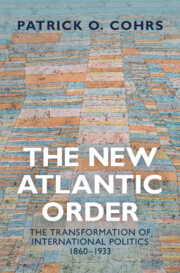Book contents
- The New Atlantic Order
- The New Atlantic Order
- Copyright page
- Dedication
- Contents
- Acknowledgements
- Abbreviations
- Maps
- Introduction
- Part I Inevitable Descent into the Abyss?
- Part II The Greatest War – and No Peace without Victory
- Part III Reorientations and Incipient Learning Processes
- 10 Towards a Progressive Atlantic Peace of the Victors
- 11 The Search for a New Equilibrium – and an Atlantic Concert
- 12 The Search for Security and an Atlantic Alliance of the Victors
- 13 A New Beginning?
- Part IV No Pax Atlantica
- Epilogue The Political Consequences of the Peace
- Bibliography
- Index
10 - Towards a Progressive Atlantic Peace of the Victors
The Reorientation of American Approaches to Peace and International Order
from Part III - Reorientations and Incipient Learning Processes
Published online by Cambridge University Press: 22 April 2022
- The New Atlantic Order
- The New Atlantic Order
- Copyright page
- Dedication
- Contents
- Acknowledgements
- Abbreviations
- Maps
- Introduction
- Part I Inevitable Descent into the Abyss?
- Part II The Greatest War – and No Peace without Victory
- Part III Reorientations and Incipient Learning Processes
- 10 Towards a Progressive Atlantic Peace of the Victors
- 11 The Search for a New Equilibrium – and an Atlantic Concert
- 12 The Search for Security and an Atlantic Alliance of the Victors
- 13 A New Beginning?
- Part IV No Pax Atlantica
- Epilogue The Political Consequences of the Peace
- Bibliography
- Index
Summary
Chapter 10 reappraises the evolving plans and visions for a League of Nations and a new, progressive international order that were advanced by Woodrow Wilson and those who came to advise the American president and contribute to the American peace agenda that was presented at the Paris Peace Conference. It reinterprets Wilson’s core aspiration as, essentially, the pursuit of a new Atlantic order – rather than a “new world order”. And it not only analyses the underlying assumptions and maxims of the peace programme that he and his core advisers elaborated after the end of the Great War – and the crucial changes they made to this programme and their approaches to peacemaking during the critical phase between the armistice and the peace negotiations at Versailles. It also evaluates how far Wilson and his advisers had drawn deeper lessons from the war – and how far the president’s reorientated ideas and strategies for a “peace to end all wars” actually met essential requirements that had to be fulfilled to create a durable and legitimate postwar order in and beyond the newly vital transatlantic sphere.
Keywords
- Type
- Chapter
- Information
- The New Atlantic OrderThe Transformation of International Politics, 1860–1933, pp. 351 - 424Publisher: Cambridge University PressPrint publication year: 2022

